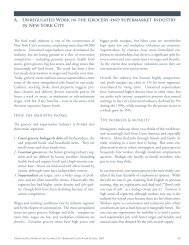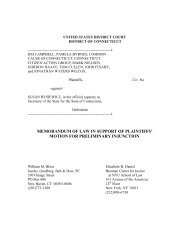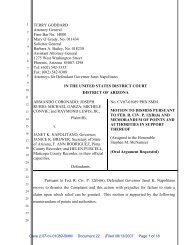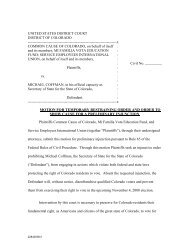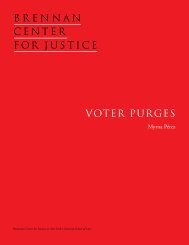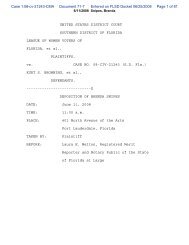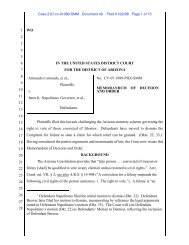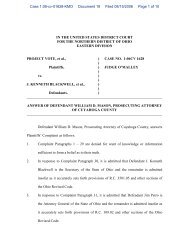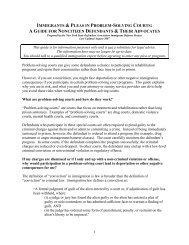howardhallis.com,” a comedy and comic-booksite. 168 After notification from the ISP, Hallisdeleted the parody artwork, and wrote ruefully:“Taken down due to legal stuff. … Sorry folks.Cthulhu destroys all that you love!” He added: “Imyself don’t agree with Chick’s fundamentalistChristianity … The piece was done in fun, butyou got to realize that the laws can censor you.”A reader responded:i was very impressed by your “CthulhuChick Tract” – i thought it was hilarious,and a nice spoof on the original (which iconsider intellectually insulting).i am sorry that you had to take the pagedown. However, i am also surprised, as ithought that “fair use” laws allowed themodification of copyrighted material forparody purposes. 169We agreed with the reader. The religiousparodies would have had a strong fair use defense.• An April 2004 letter to Google from AirTranAirways demanded the removal of links topages on 2600.com: The Hacker Quarterly,a site that critiqued AirTran’s poor safetyrecord. AirTran complained that 2600 hadreproduced its Web pages “in their entirely, orin substantial, verbatim excerpts “ 170 One page,dated September 24, 1997 and headlined “SoWe Killed a Few People, Big Deal,” contained aparody press release that began:ValuJet Airlines today changed its name toAirTran Airlines and along with its mergerpartner AirTran Airways introduced anew business strategy designed to bringdismemberment to a broader travelaudience. The airline said that its objectiveis to make air travel more attractiveto business travelers and even moreconvenient for suicidal maniacs. 171Another page, headlined “Hacked,” reproducedan AirTran Web page and suggested thatValuJet's merger with AirTran was intendedto distract public attention from a 1996 Valu-Jet crash that killed 110 people. 172 These pagesare still up. Their use of copyrighted and trademarkedmaterial created little likelihood of confusionand had a strong claim to fair use.• The operator of netfunny.com received aletter from American Express in April 2004,demanding that he stop using the terms“American Expressway” and “MembershipJustin Hampton, Cover of Danger Mouse’s Grey AlbumHas Its Privileges” because they are “virtuallyidentical to our client’s American Expressmark” and are “likely to cause consumers tobe confused, mistaken, or deceived as to thesource of origin of your services.” 173 A visit tonetfunny.com shows that its American Expressparody is still posted, with a link to a site where“you can read about an effort by AmericanExpress to get this joke deleted. ” On that page,blogger Brad Templeton writes that he receiveda “one of those bullying ‘cease and desist’letters from American Express’s law firm,” andproceeded to post another parody, this time ofAmex’s lawyers, concluding: “After all, BeingGiant and Intimidating has its Privileges. …American Express Lawyers: Don’t leave yourhome page without them.” 174Contrary to Amex’s claim, there was littlelikelihood of confusion here, and netfunny’sFirst Amendment defense was a strong one.• A February 2004 email from the DiscoveryChannel to what was probably a fan site demandedthe removal of a TV program’s logo, text,and photographs. The email acknowledged that“you are using the trademarks and photographsto facilitate commentary about Discovery’s programs,”but explained: “if Discovery permits34 Will Fair Use Survive?
your unauthorized use of its intellectual property,Discovery may have trouble preventingfuture egregious infringements by competitorsand persons intending to trade off the goodwillof Discovery.” 175 We categorized this probablefan site as having a reasonable fair use defensebecause the copied material was accompaniedby commentary.• Another fan site, for the TV show Carolinein the City, included transcripts from the show’sepisodes, plot summaries, and fan fiction.The operator received a cease and desist letterfrom CBS-TV in January 2004, claimingboth copyright and trademark infringement.Although the letter noted that “you may nothave been aware of the applicable laws,” andsaid CBS was “quite happy to know” thatCaroline in the City had loyal fans, it threatenedlegal action if the material was not removed.The letter went on: “please understand thatit doesn’t bring us any pleasure to send legalletters to our fans.” 176We thought the site had a reasonable fair usedefense because its transcripts and summarieswere posted in the context of commentary,were not for profit, and were more likely toincrease than interfere with the market for theTV show. 177 However, the owner removed thetranscripts and fan fiction, explaining that shehad received a cease and desist letter. This resultedin an outcry from fans, and a few months later, anew owner re-posted summaries of episodes, butnot the transcripts. She wrote: “woo, I got rid ofthat depressing letter Ann posted a few monthsago. And if you look closely on the left, you’rein for a little surprise: The dearly missed sectionis back!!” There was also a disclaimer explainingthat the site is nonprofit and has no connectionwith the producers of the show. 178• Seven letters from Capitol Records/EMI inFebruary 2004 warned against any distributionof DJ Danger Mouse’s Grey Album, a “mash-up”using the rapper Jay Z’s then-recently releasedBlack Album mixed with songs such as “Julia,”“Happiness is a Warm Gun,” and “RockyRaccoon” from the Beatles’s 1968 White Album.Hundreds of Web sites had announced thatthey would post the album on “Grey Tuesday,”February 24, 2004, as a gesture of protest againsta copyright system that fails to acknowledgethe importance of mixing and sampling tomusical creation. The letters demanded notonly that The Grey Album not be distributedbut that recipients identify “any third parties”who had supplied them with copies, providean accounting “of all units of The Grey Albumthat have been distributed via your website,” and“make payment to Capitol in an amount to bediscussed.” 179Danger Mouse himself, Brian Burton,had agreed to Capitol’s demands, and so didsome recipients of the threatening letters.But DownhillBattle.org, coordinator of GreyTuesday, reported that “for 24 hours, over170 sites made the album available in protest,defying legal threats.” 180 To the letter from EMIthat Downhill Battle itself received, the groupresponded that “your efforts to suppress musicstifle creativity and harm the public i nterest;we will not be intimidated into backing down.Downhill Battle has a fair-use right to post thismusic under current copyright law and thepublic has a fair-use right to hear it.” 181The Electronic Frontier Foundation (EFF)posted a legal memo that bolstered the protesters’claim to a fair use defense. Distribution of TheGrey Album, EFF said, was for a noncommercialpurpose; downloads would not “substitute forpurchases of The White Album or other recordingsof the Lennon-McCartney songs on the album”;The Grey Album was “a transformative use of TheWhite Album, not a wholesale copy”; and thepostings were intended as “a commentary onthe use of copyright law to stymie new kinds ofmusical creativity.” 182 Although some copyrightexperts might consider EFF’s analysis to be astretch for fair use, certainly The Grey Album wasa creative and transformative use of the Beatles’material – a major factor in fair use cases.Summary and ConclusionsThe chart below summarizes the impact ofthe 153 letters in the Chilling Effects databasefor 2004 that either targeted material with a fairuse/First Amendment defense or that stated aweak IP claim.These numbers indicate, not surprisingly,that the stronger the claim to fair use or otherBrennan Center for Justice 35
- Page 1 and 2: WILLFAIR USESURVIVE?Free Expression
- Page 3 and 4: WILLFAIR USESURVIVE?Free Expression
- Page 5: ContentsExecutive Summary . . . . .
- Page 9 and 10: unhappy years of World War II.” 1
- Page 11 and 12: Although §512 does allow an ISP
- Page 13 and 14: music, distance learning, interlibr
- Page 15 and 16: CHAPTER 1The Legal LandscapeThis ch
- Page 17 and 18: Court’s “Oh, Pretty Woman” de
- Page 19 and 20: the public would be confused about
- Page 21 and 22: CHAPTER 2Quoting Sartre, Using Prok
- Page 23 and 24: owned by Gallimard [the French publ
- Page 26 and 27: well, this and this person gave it
- Page 28 and 29: you can do with the pages of Time a
- Page 30 and 31: going to start writing letters for
- Page 32 and 33: causing problems for our communitie
- Page 34 and 35: or Not’ people. So we took it dow
- Page 36 and 37: The American Pool Players Associati
- Page 38 and 39: “Paris Hilton Sex Tape” 150 (ho
- Page 42 and 43: legitimate borrowing of protected m
- Page 44 and 45: Dan Hamilton, managing editor of th
- Page 46 and 47: legal action as long as eInfoworld
- Page 48 and 49: At that point, Cox took to the blog
- Page 50 and 51: her books, but not created by Anne
- Page 52 and 53: CHAPTER 5Internet Infidels and Home
- Page 54 and 55: she attributed to the many form let
- Page 56 and 57: “Without his permission, the gove
- Page 58 and 59: eproducing an artwork in a book wit
- Page 60 and 61: ConclusionWhat can we learn from th
- Page 62 and 63: Reiff thought that instead, the gov
- Page 64 and 65: Endnotes1 Mattel v. Walking Mountai
- Page 66 and 67: 48 See Katie Dean, “Eyes on the P
- Page 68 and 69: 109 Not an exact quote. See Alan Al
- Page 70 and 71: 149 http://msophelia.blogspot.com/p
- Page 72 and 73: 215 “MBA Legal Defense Initiative
- Page 74 and 75: lank left hand page
- Page 76: 161 Avenue of the Americas12 th Flo



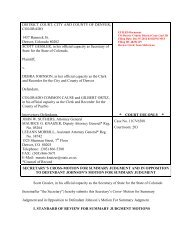
![Download the Letter [PDF] - Brennan Center for Justice](https://img.yumpu.com/50139248/1/190x245/download-the-letter-pdf-brennan-center-for-justice.jpg?quality=85)
